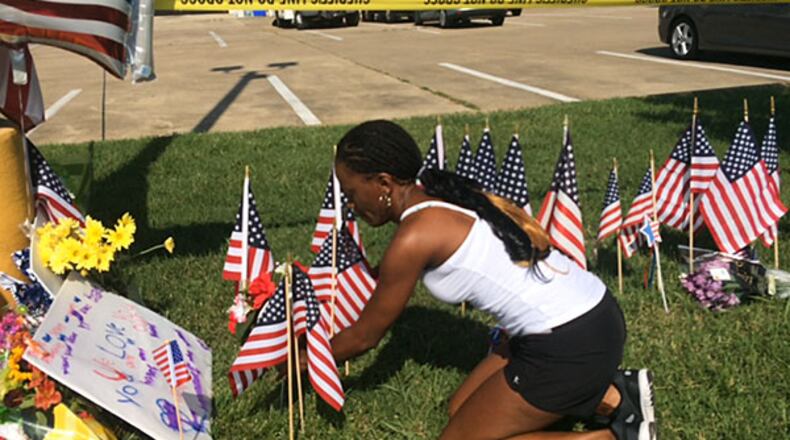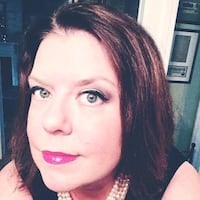“We’re not safe anywhere, are we?”
U.S. Army veteran Diondra Pointer planted flags in the ground after a gunman hit two military sites here.
“My heart really hurts,” Pointer said after the 2015 attacks. “These were fathers and brothers and sons of somebody. I just wanted to pay my respects.”
Four years later, Pointer is a nurse who works the night shift. She runs errands during her 1 a.m. lunch break, the only time she feels safe at big-box stores.
“It has definitely changed the way I shop,” she said this week of Muhammad Youssef Abdulazeez’ rampage that killed Lance Cpl. Skip Wells of Marietta and four other servicemen. “I am real skeptical about going to the mall.”
In Orlando, graphic artist Nicki Drumb and her wife, Rachel Gardiner (shown in the photo below), check for exits at events likely to draw a crowd.
“It’s my new reality,” Drumb said. Omar Mateen opened fire at Orlando’s Pulse nightclub in June 2016, leaving 49 victims dead. Like Abdulazeez, Mateen was killed by law enforcement. The massacres left lasting emotional scars.
“As soon as another shooting happens, I make a point not to obsess about it,” Drumb said.
The list keeps growing. A February 2018 at a Parkland, Fla. school left 17 victims dead. A November 2018 shooting in a Thousand Oaks, Calif. bar left 12 victims and the gunman dead. A shooting last month at a Gilroy, Calif. festival left three victims and gunman dead. Last weekend, shootings in El Paso, Tex. and Dayton, Ohio left 31 victims dead.
“It seems to be happening all too often and there’s no end in sight,” said Jennifer Foster, also of Orlando. “Our culture is forever changed.”
Hours after the Dayton shooting, Mayor Nan Whaley offered weary thanks to mayors for their grim expertise.
“I think I’ve had over 70 mayors from across the country reach out. Particularly of help have been Buddy Dyer of Orlando, who had to work with his community through the Pulse nightclub (shooting) and Mayor Bill Peduto of Pittsburgh, obviously with the Tree of Life Synagogue,” she said, referring to the October 2018 shooting for which Robert Gregory Bowers faces about 100 state and federal charges. “Unfortunately, because we have so many of these incidences, there is a bevy of mayors that are able to give great advice and feedback.”
Dayton police officers fatally shot gunman Connor Betts seconds after his rampage began about 1 a.m. Sunday. His sister, Megan Betts, was among the victims.
As mass shootings continue to grip communities across the country, an unofficial confederation of survivors has become a helpful network.
“It’s a club no one wants to be a part of,” said Chris Williford, a nurse who was at the 2017 music festival in Las Vegas where gunman Stephen Craig Paddock killed 58 and injured more than 400. Afterward, she heard from people who had lived through Orlando’s shooting.
While Orlando was in mourning days after the Pulse shooting, Rev . Dr. Betty Deas Clark, then pastor of "Mother" Emanuel AME Church in Charleston, joined a vigil there.
“I am here because of the love of the love shown to us at Mother Emanuel,” Deas, whose church was the site of a 2015 shooting that left nine worshippers dead, said then. “We must pray not just for today, but for tomorrow.”
Tomorrow is here, and with it more vigils, more survivors of past shootings reaching out to those in fresh grief.
This week, Williford and fellow Vegas concertgoer Kody Robertson went to a downtown Dayton vigil on Sunday night to offer their uniquely empathetic support.
“You just really need to lean on people,” Williford said. She wasn’t among the shooting victims, but was banged up and bloodied during the stampede for the exits after shots rang out that night on the Vegas Strip. Her medical training kicked in that night. She whipped off her belt to use as a tourniquet on one victim’s bleeding leg, and kept pressure on another’s wounded stomach.
“When the crowd started moving. he started picking people off,” she said of Paddock, who shot himself as authorities closed in. Only later did the trauma and survivor’s guilt hit her. Events like the shooting close to home trigger profound new waves of anxiety.
“I woke up screaming for help two nights ago,” she said. “I take medicine to help me sleep. I don’t think any medicine could have helped in the last two days.”
There have been 17 deadly mass shootings in 2019, meaning those that claimed the lives of four or more victims, according to an ABC News study. These included workplace and domestic violence incidents and robbery and brawl incidents that turned deadly as well as the apparently random attacks in El Paso and Dayton over the weekend.
Author Dave Cullen, whose books “Columbine” and “Parkland” detail the tragedies at the two high schools with particular attention to what the press and others got wrong (hint: a lot), cautions against using superlative language in covering such events.
El Paso suspect Patrick Wood Crusius has been charged with capital murder and faces the death penalty.
The first mass shooting I covered for The Atlanta Journal-Constitution was here, in July 1999. Failed day trader Mark Barton killed his wife and two children, then nine people where he worked, before shooting himself. This was two months after a Conyers high school shooting left six students wounded and about three months after the Columbine High School shootings that left 13 victims dead; teen gunmen Eric Harris and Dylan Klebold shot themselves.
In recent years, the AJC has sent me to cover mass shootings again and again. I just returned from Dayton.
The tragedies are similar yet unique, all terrible in newly terrible ways. Each time I have dispatched to a city convulsing in grief, it has been wrenching to talk with mourners, heartening to see communities band together and draining to see it keep happening.
Drumb, the Orlando artist, looked for a ray of hope amid the sorrow of the Parkland high school shooting that left 17 dead. Former student Nikolas Cruz faces the death penalty.
“I felt kind of bad for thinking this but I thought, ‘Now we’ll do something, now that it’s children. They’re going to do something now,’” Drumb said. “I really thought, ‘This is going to fix it.’”
It didn’t.
The moniker “(Our Town) Strong” has become a familiar hashtag as I report from one chaotic scene after another. People used to say “never again,” too. I’ve noticed they don’t anymore.
“What’s changed? Absolutely nothing. That’s the maddening pain of it,” said Father Joshua Whitfield, pastoral administrator for St. Rita Catholic Community in Dallas, Texas. “We’re to the point where we’re just trying to cope and stay sane.”
Gunman Micah Xavier Johnson opened fire in downtown Dallas in July 2016, leaving five officers dead. Johnson was killed by law enforcement. I hadn’t unpacked from covering the Pulse nightclub shootings when I was sent to Dallas.
Three years later, the community remains on alert.
“We have a Dallas police officer at every Mass now,” Whitfield said. “People need to feel safe.”
He laments having to fortify the building, mindful that the presence of law enforcement could be unsettling for some in his flock.
“On any given Sunday you have hard core, build-the-wall Trumpers sitting with undocumented immigrants,” he said. “When you make the faith space a fortress, something happens to the faith. We have to be a community that lives and loves and prays together.”
Whitfield was on vacation with his family this week. An open-air concert at the beach had him on alert, just another in a litany of small changes to life since the downtown Dallas shootings.
“It taints every experience,” he said. “It’s the creep, the cancer of fear and suspicion. What does it make us? What does it turn us into? We’re not very free.”
About the Author
Keep Reading
The Latest
Featured










